Abstract
Peptostreptococcus elsdenii, a strict anaerobe from the rumen, was grown on a medium containing yeast extract and [1-14C]- or [2-14C]-lactate. Radioisotope from lactate was found in all cell fractions, but mainly in the protein. The label in the protein fraction was largely confined to a few amino acids: alanine, serine, aspartic acid, glutamic acid and diaminopimelic acid. The alanine, serine, aspartic acid and glutamic acid were separated, purified and degraded to establish the distribution of 14C from lactate within the amino acid molecules. The labelling patterns in alanine and serine suggested their formation from lactate without cleavage of the carbon chain. The pattern in aspartic acid suggested formation by condensation of a C3 unit derived directly from lactate with a C1 unit, probably carbon dioxide. The distribution in glutamic acid was consistent with two possible pathways of formation: (a) by the reactions of the tricarboxylic acid cycle leading from oxaloacetate to 2-oxoglutarate, followed by transamination; (b) by a pathway involving the reaction sequence 2 acetyl-CoA→crotonyl-CoA→glutaconate→glutamate.
Full text
PDF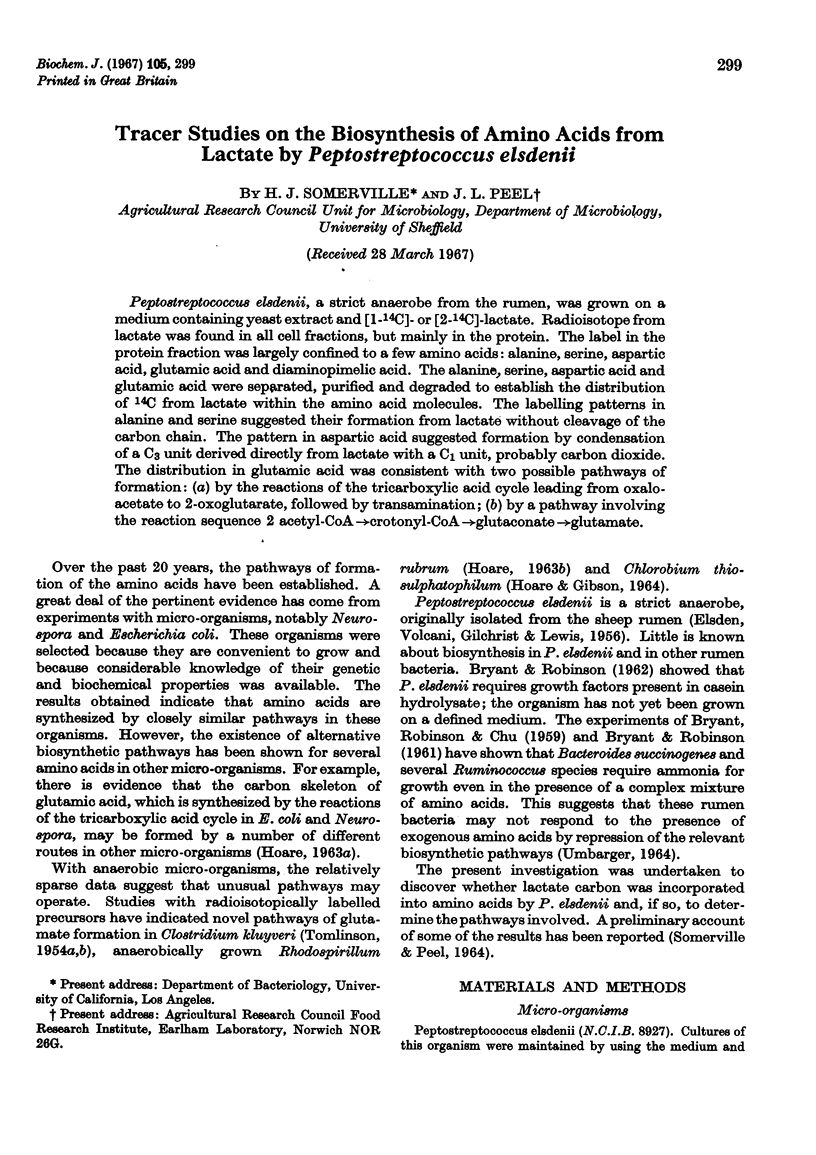
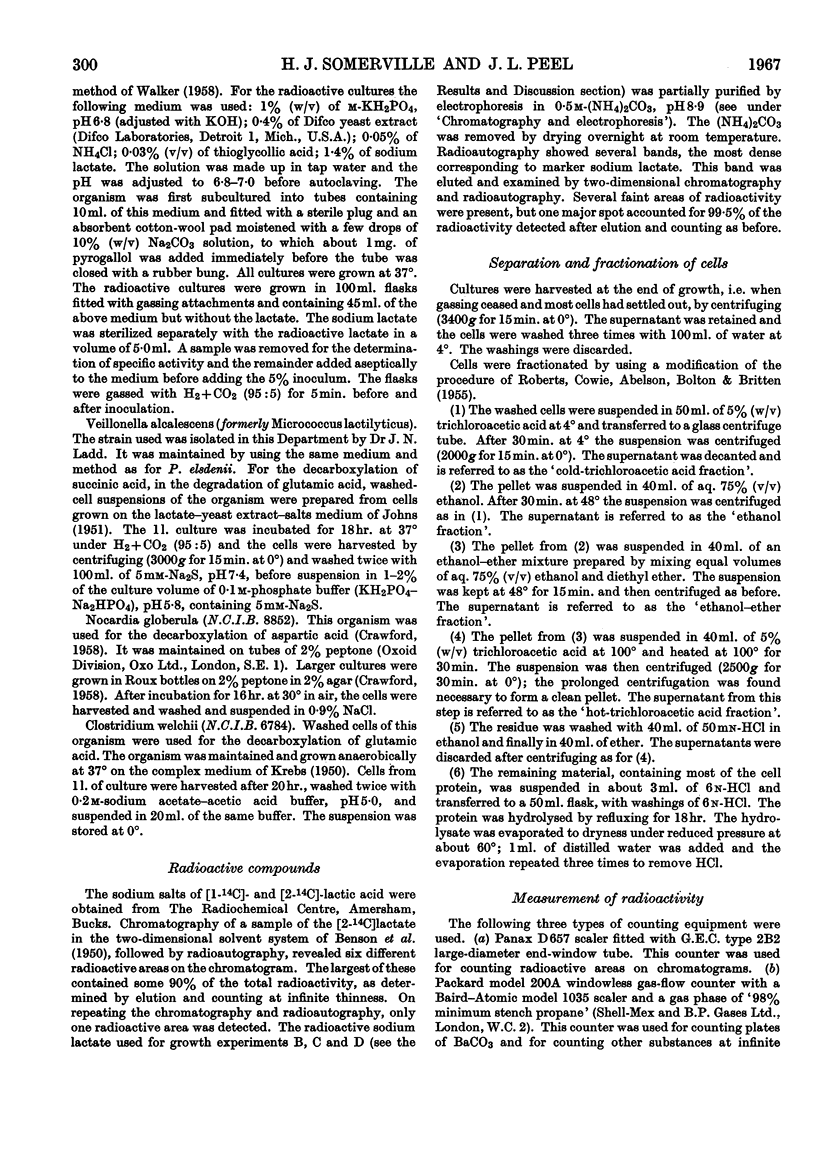
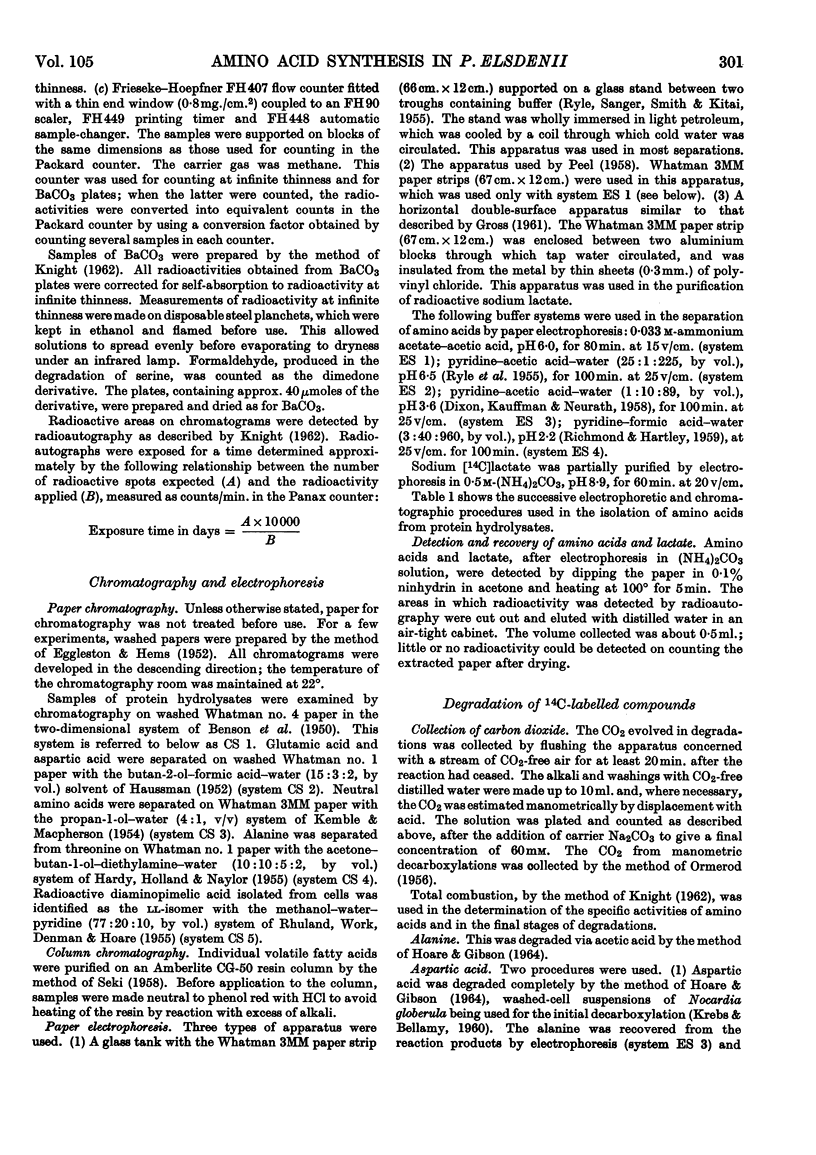
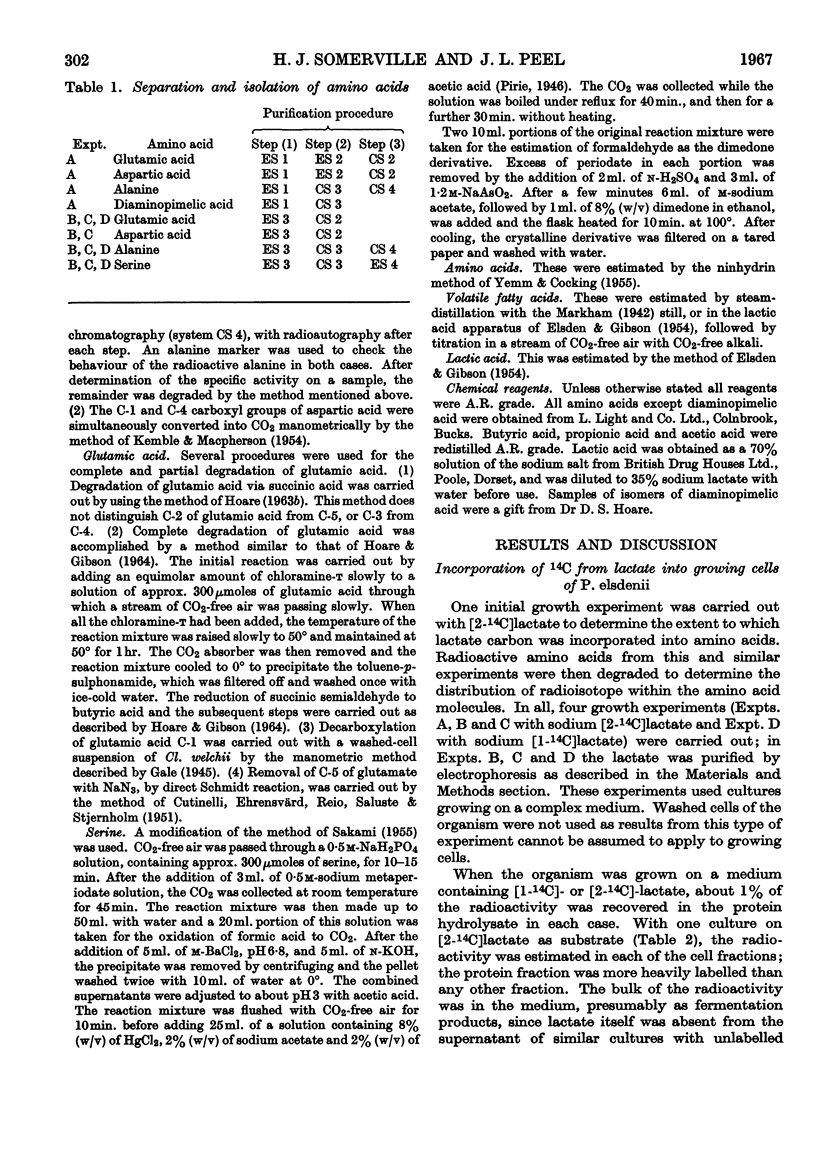
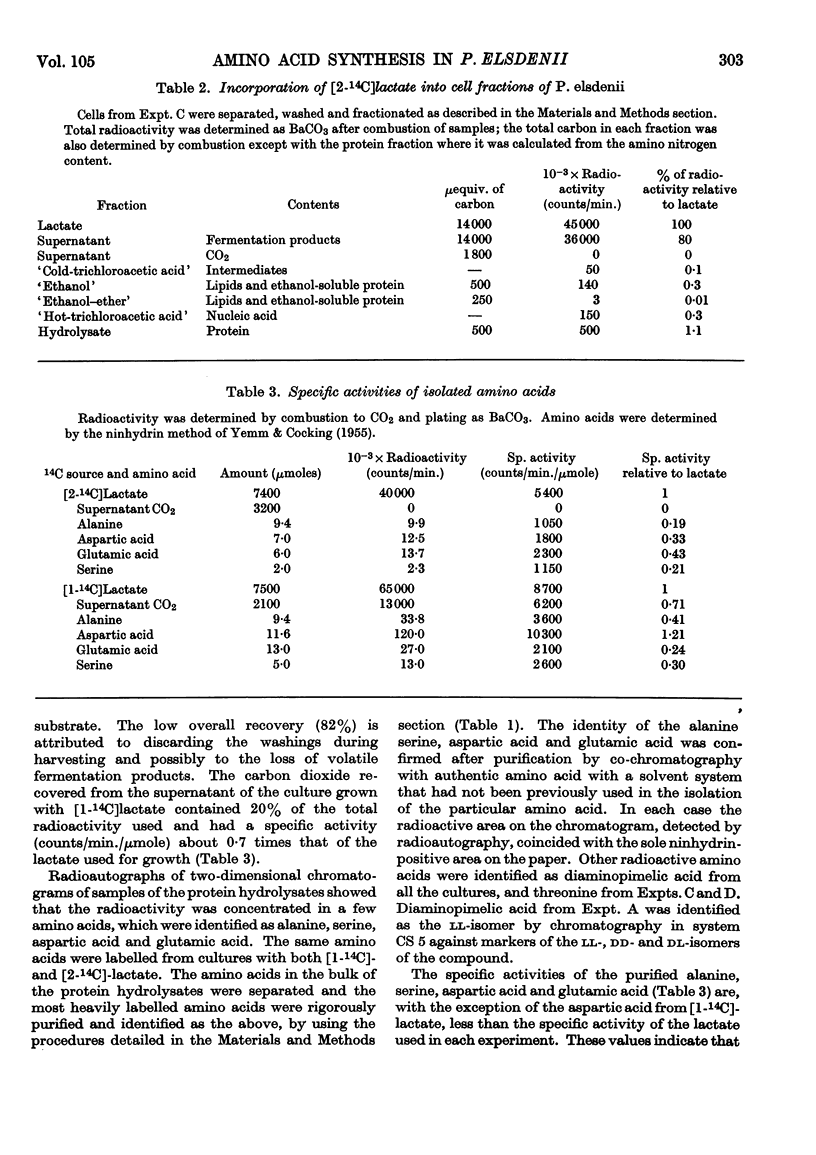
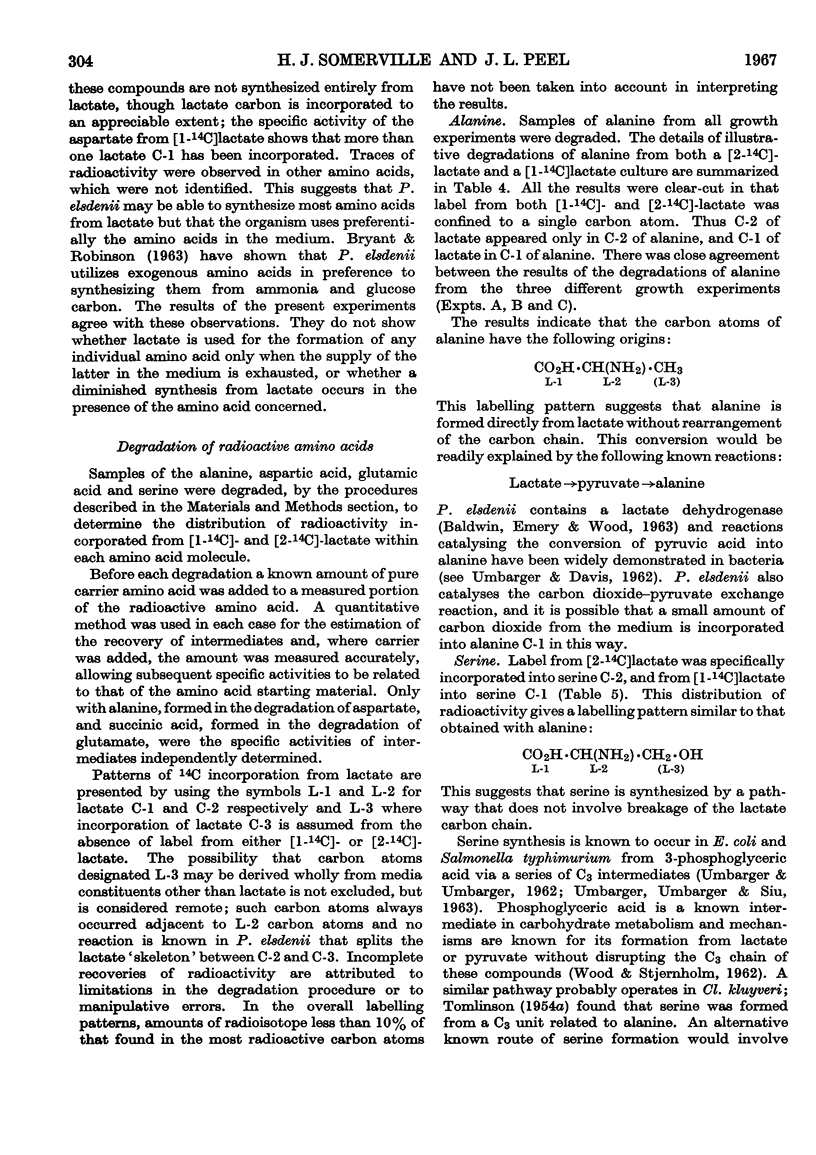
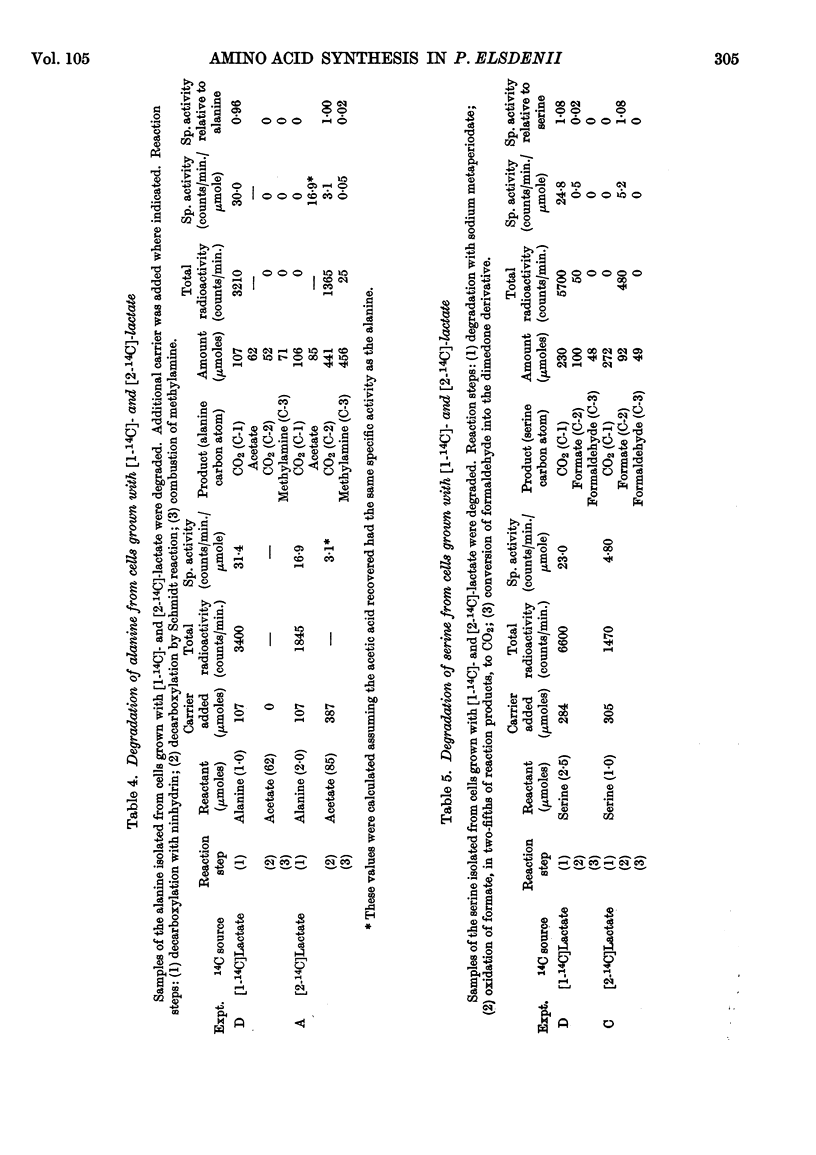
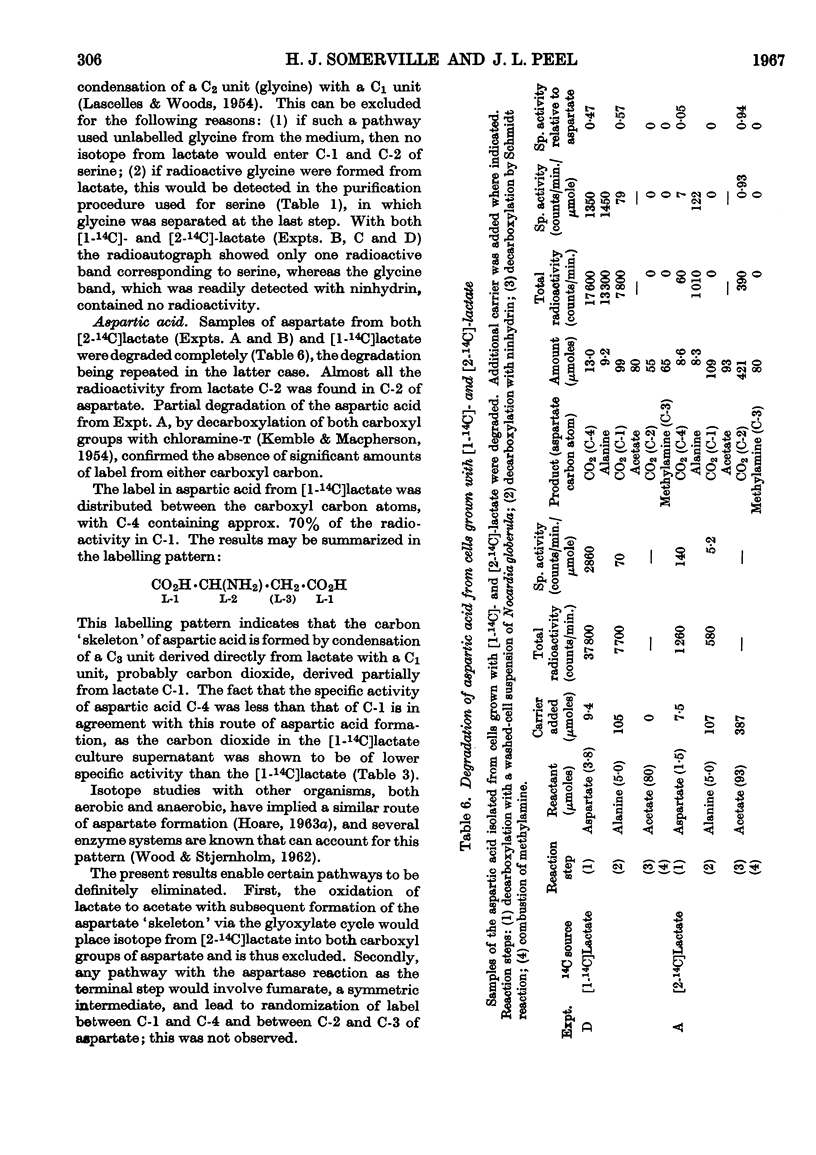
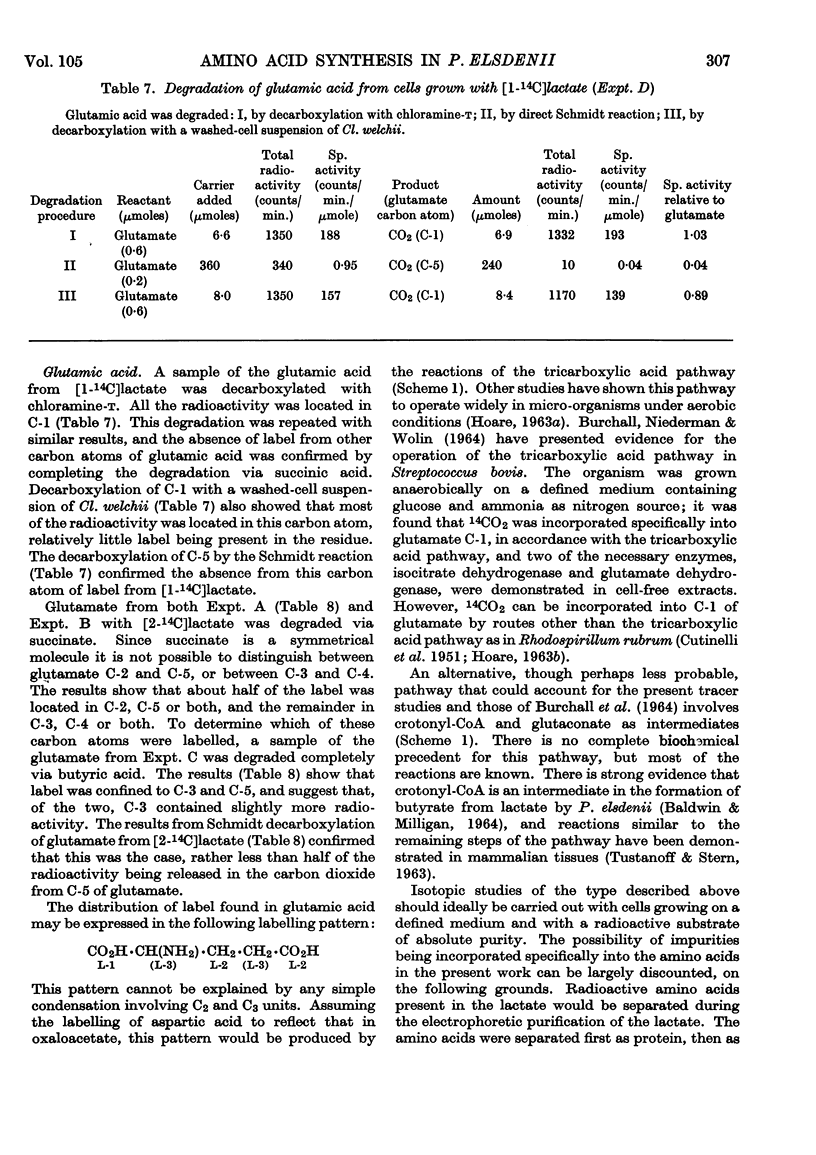
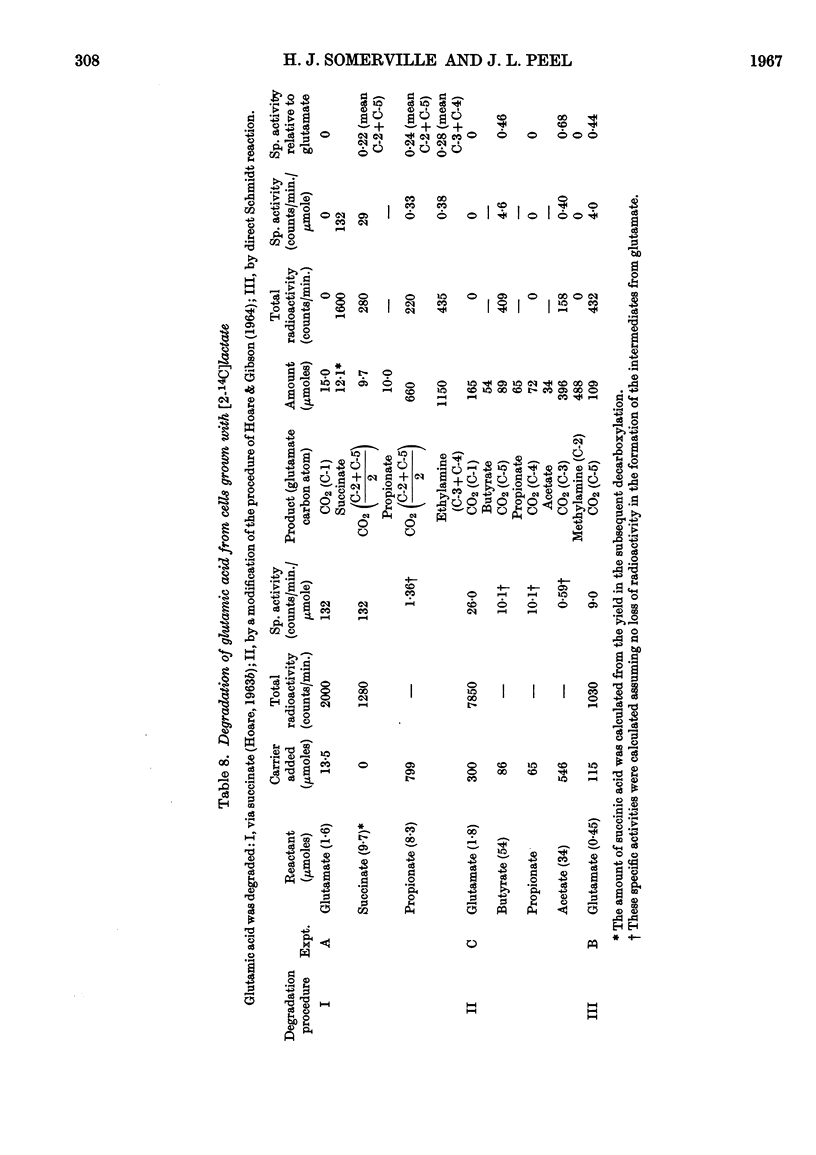
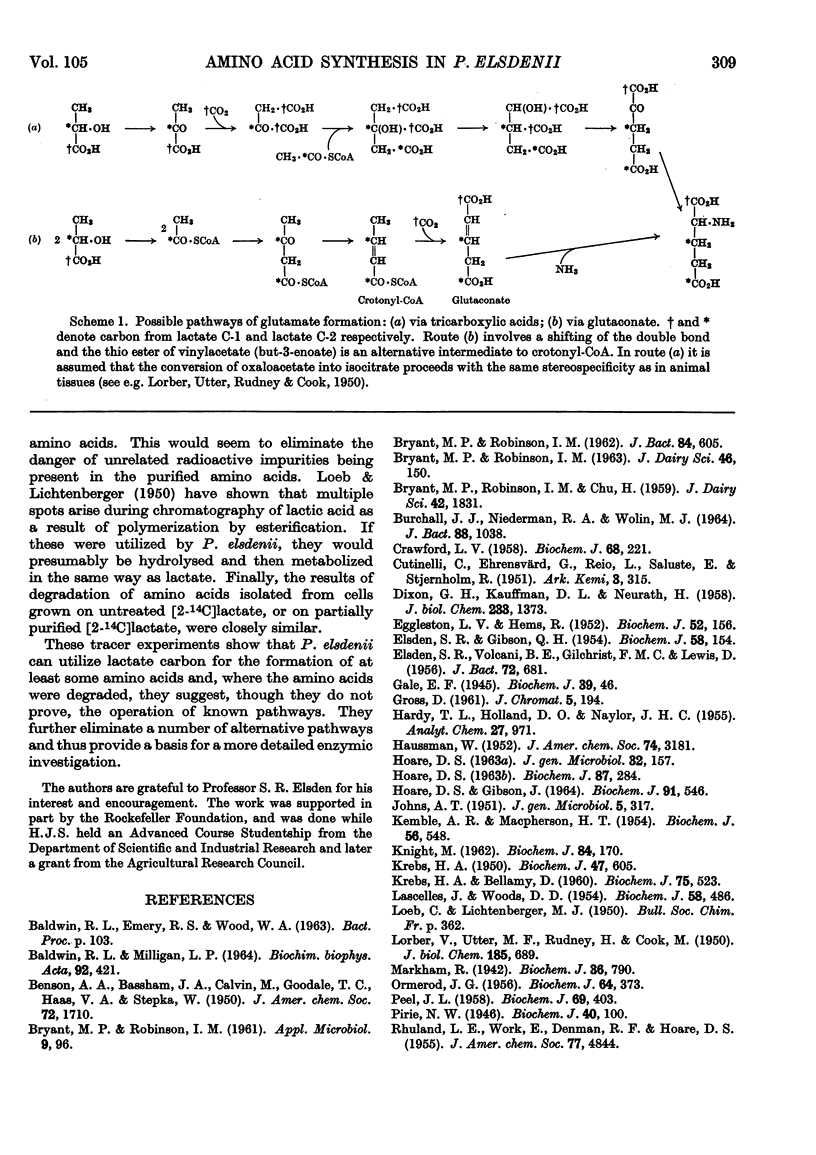
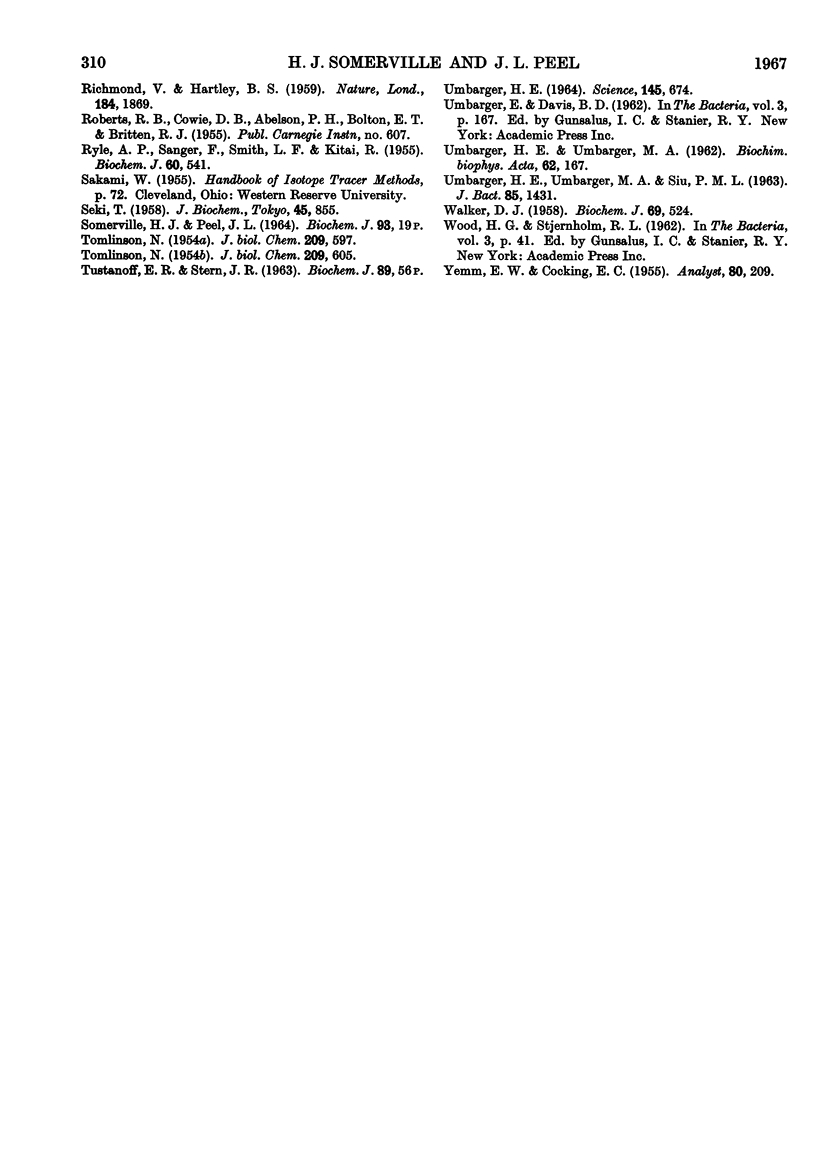
Selected References
These references are in PubMed. This may not be the complete list of references from this article.
- BALDWIN R. L., MILLIGAN L. P. ELECTRON TRANSPORT IN PEPTOSTREPTOCOCCUS ELSDENII. Biochim Biophys Acta. 1964 Dec 23;92:421–432. doi: 10.1016/0926-6569(64)90001-x. [DOI] [PubMed] [Google Scholar]
- BRYANT M. P., ROBINSON I. M. Some nutritional characteristics of predominant culturable ruminal bacteria. J Bacteriol. 1962 Oct;84:605–614. doi: 10.1128/jb.84.4.605-614.1962. [DOI] [PMC free article] [PubMed] [Google Scholar]
- BURCHALL J. J., NIEDERMAN R. A., WOLIN M. J. AMINO GROUP FORMATION AND GLUTAMATE SYNTHESIS IN STREPTOCOCCUS BOVIS. J Bacteriol. 1964 Oct;88:1038–1044. doi: 10.1128/jb.88.4.1038-1044.1964. [DOI] [PMC free article] [PubMed] [Google Scholar]
- Bryant M. P., Robinson I. M. Studies on the Nitrogen Requirements of Some Ruminal Cellulolytic Bacteria. Appl Microbiol. 1961 Mar;9(2):96–103. doi: 10.1128/am.9.2.96-103.1961. [DOI] [PMC free article] [PubMed] [Google Scholar]
- CRAWFORD L. V. Studies on the aspartic decarboxylase of Nocardia globerula. Biochem J. 1958 Feb;68(2):221–225. doi: 10.1042/bj0680221. [DOI] [PMC free article] [PubMed] [Google Scholar]
- DIXON G. H., KAUFFMAN D. L., NEURATH H. Amino acid sequence in the region of diisopropylphosphoryl binding in diisopropylphosphoryl-trypsin. J Biol Chem. 1958 Dec;233(6):1373–1381. [PubMed] [Google Scholar]
- EGGLESTON L. V., HEMS R. Separation of adenosine phosphates by paper chromotography and the equilibrium constant of the myokinase system. Biochem J. 1952 Sep;52(1):156–160. doi: 10.1042/bj0520156. [DOI] [PMC free article] [PubMed] [Google Scholar]
- ELSDEN S. R., GIBSON Q. H. The estimation of lactic acid using ceric sulphate. Biochem J. 1954 Sep;58(1):154–158. doi: 10.1042/bj0580154. [DOI] [PMC free article] [PubMed] [Google Scholar]
- ELSDEN S. R., GILCHRIST F. M., LEWIS D., VOLCANI B. E. Properties of a fatty acid forming organism isolated from the rumen of sheep. J Bacteriol. 1956 Nov;72(5):681–689. doi: 10.1128/jb.72.5.681-689.1956. [DOI] [PMC free article] [PubMed] [Google Scholar]
- Gale E. F. Studies on bacterial amino-acid decarboxylases: 5. The use of specific decarboxylase preparations in the estimation of amino-acids and in protein analysis. Biochem J. 1945;39(1):46–52. doi: 10.1042/bj0390046. [DOI] [PMC free article] [PubMed] [Google Scholar]
- HOARE D. S. THE BREAKDOWN AND BIOSYNTHESIS OF GLUTAMIC ACID. J Gen Microbiol. 1963 Aug;32:157–161. doi: 10.1099/00221287-32-2-157. [DOI] [PubMed] [Google Scholar]
- HOARE D. S. The photo-assimilation of acetate by Rhodospirillum rubrum. Biochem J. 1963 May;87:284–301. doi: 10.1042/bj0870284. [DOI] [PMC free article] [PubMed] [Google Scholar]
- Hoare D. S., Gibson J. Photoassimilation of acetate and the biosynthesis of amino acids by Chlorobium thiosulphatophilum. Biochem J. 1964 Jun;91(3):546–559. doi: 10.1042/bj0910546. [DOI] [PMC free article] [PubMed] [Google Scholar]
- JOHNS A. T. Isolation of a bacterium, producing propionic acid, from the rumen of sheep. J Gen Microbiol. 1951 May;5(2):317–325. doi: 10.1099/00221287-5-2-317. [DOI] [PubMed] [Google Scholar]
- KEMBLE A. R., MACPHERSON H. T. Determination of monoamino monocarboxylic acids by quantitative paper chromatography. Biochem J. 1954 Apr;56(4):548–555. doi: 10.1042/bj0560548. [DOI] [PMC free article] [PubMed] [Google Scholar]
- KNIGHT M. The photometabolism of propionate by Rhodospirillum rubrum. Biochem J. 1962 Jul;84:170–185. doi: 10.1042/bj0840170. [DOI] [PMC free article] [PubMed] [Google Scholar]
- KREBS H. A., BELLAMY D. The interconversion of glutamic acid and aspartic acid in respiring tissues. Biochem J. 1960 Jun;75:523–529. doi: 10.1042/bj0750523. [DOI] [PMC free article] [PubMed] [Google Scholar]
- KREBS H. A. Manometric determination of L-aspartic acid and L-asparagine. Biochem J. 1950 Nov-Dec;47(5):605–614. doi: 10.1042/bj0470605. [DOI] [PMC free article] [PubMed] [Google Scholar]
- LASCELLES J., WOODS D. D. The synthesis of serine and Leuconostoc citrovorum factor by cell suspensions of Streptococcus faecalis R. Biochem J. 1954 Nov;58(3):486–497. doi: 10.1042/bj0580486. [DOI] [PMC free article] [PubMed] [Google Scholar]
- LORBER V., UTTER M. F., RUDNEY H., COOK M. The enzymatic formation of citric acid studied with C14-labeled oxalacetate. J Biol Chem. 1950 Aug;185(2):689–699. [PubMed] [Google Scholar]
- Markham R. A steam distillation apparatus suitable for micro-Kjeldahl analysis. Biochem J. 1942 Dec;36(10-12):790–791. doi: 10.1042/bj0360790. [DOI] [PMC free article] [PubMed] [Google Scholar]
- ORMEROD J. G. The use of radioactive carbon dioxide in the measurement of carbon dioxide fixation in Rhodospirillum rubrum. Biochem J. 1956 Oct;64(2):373–380. doi: 10.1042/bj0640373. [DOI] [PMC free article] [PubMed] [Google Scholar]
- PEEL J. L. The separation of flavins by paper electrophoresis and its application to the examination of the flavin contents of micro-organisms. Biochem J. 1958 Jul;69(3):403–416. doi: 10.1042/bj0690403. [DOI] [PMC free article] [PubMed] [Google Scholar]
- Pirie A. Ascorbic acid content of cornea. Biochem J. 1946;40(1):96–100. doi: 10.1042/bj0400096. [DOI] [PMC free article] [PubMed] [Google Scholar]
- RYLE A. P., SANGER F., SMITH L. F., KITAI R. The disulphide bonds of insulin. Biochem J. 1955 Aug;60(4):541–556. doi: 10.1042/bj0600541. [DOI] [PMC free article] [PubMed] [Google Scholar]
- TOMLINSON N. Carbon dioxide and acetate utilization by Clostridium kluyveri. II. Synthesis of amino acids. J Biol Chem. 1954 Aug;209(2):597–603. [PubMed] [Google Scholar]
- TOMLINSON N. Carbon dioxide and acetate utilization by Clostridium kluyveri. III. A new path of glutamic acid synthesis. J Biol Chem. 1954 Aug;209(2):605–609. [PubMed] [Google Scholar]
- UMBARGER H. E., UMBARGER M. A., SIU P. M. BIOSYNTHESIS OF SERINE IN ESCHERICHIA COLI AND SALMONELLA TYPHIMURIUM. J Bacteriol. 1963 Jun;85:1431–1439. doi: 10.1128/jb.85.6.1431-1439.1963. [DOI] [PMC free article] [PubMed] [Google Scholar]
- Umbarger H. E. Intracellular Regulatory Mechanisms: Regulation in multicellular forms may be an elaboration upon the pattern evolved in microorganisms. Science. 1964 Aug 14;145(3633):674–679. doi: 10.1126/science.145.3633.674. [DOI] [PubMed] [Google Scholar]
- WALKER D. J. The purification and properties of the L-threonine deaminase of the rumen micro-organism LC1. Biochem J. 1958 Aug;69(4):524–530. doi: 10.1042/bj0690524. [DOI] [PMC free article] [PubMed] [Google Scholar]


